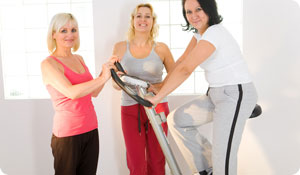
No one disputes the importance of exercise for keeping the debilitating symptoms of rheumatoid arthritis at bay. Joints that are used stay more flexible and mobile and may be less likely to incur further damage. But certain activities are better for you than others. Here are a few workouts you may want to try--and a couple you might be better off avoiding:
- Swimming or water aerobics. Water exercise is ideal for reducing the pain and stiffness associated with arthritis. The water's buoyancy gives extra support to overburdened joints, and its warmth can raise body temperature and improve circulation. In addition, water may provide enough resistance to give your muscles a gentle workout. Swimming laps is a terrific way to get cardiovascular exercise, or try a group aerobics class.
- Cycling. If balance issues make getting out on the road an impossibility for you, exercising on a stationary bike is a great alternative. Start slowly, gradually building up from a few minutes a few times a day (if you've been inactive) to half an hour, 45 minutes, or even an hour at a time. Cycling offers an excellent cardiovascular workout without putting undue stress on joints. You can use a stationary bike at the gym or try a group spinning class.
- Walking. Simple, easy, and free--those are the reasons walking is such an ideal workout. But you can't just shuffle along if you want to reap the health benefits. Try for a moderate pace that you can maintain for 30 minutes to an hour. This will build muscle and joint strength along with cardiovascular fitness. Find walking boring? Take along a buddy or wear headphones to listen to music. And if the weather doesn't cooperate, a treadmill fits the bill nicely.
While keeping active is your goal, overdoing it definitely is not. Here are two workouts you might want to rethink if you've got rheumatoid arthritis:
- Heavy weight lifting. Strength training is wonderful for building muscle and bone strength, but going for the biggest, heaviest weights you can hold will overstress your joints. Start with light weights and multiple repetitions to see what your body can handle, and build up slowly.
- Running. While some people with rheumatoid arthritis may feel fine after running, it's known that high-impact exercise can put too much stress on joints. If you must run, look for dirt trails or high-school tracks that have more "give" than paved or concrete surfaces.
Sources
Arthritis Foundation, www.arthritistoday.org.





